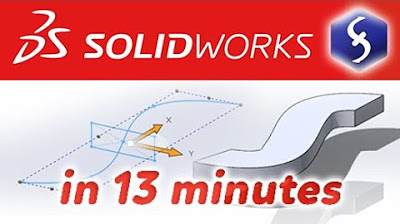Aturan Gambar Teknik Mesin (Gambar Kerja) - Gambar Teknik Manufaktur
Summary
TLDRThis video lecture provides a comprehensive guide to creating technical drawings for manufacturing, focusing on machine components like the 'arbor.' Key topics include technical drawing standards, tolerances (linear, fitting, and geometric), surface roughness, and the correct use of machining symbols. The importance of clear, detailed, and unambiguous drawings for machine operators is emphasized, with examples of part dimensions, material specifications, and machining processes. The lecture underscores the need for accurate, complete technical documentation to ensure smooth production and prevent errors during the manufacturing process.
Takeaways
- 😀 The importance of clear technical drawings in machine manufacturing is emphasized to avoid confusion for operators.
- 😀 Work drawings must include detailed information such as the component name, material type, and manufacturing tolerances.
- 😀 Proper title blocks (etiket) must be used, including project details, designer's name, material specifications, and the date of creation.
- 😀 Projections in technical drawings should use the appropriate system, such as American projection, to clearly represent components.
- 😀 Complete dimensions and tolerances should be provided for each part to facilitate accurate manufacturing processes.
- 😀 Surface roughness for different parts must be clearly specified using symbols like N7 and M5 to indicate required machining finishes.
- 😀 Special tolerances, like fits (e.g., H7), should be applied where necessary to ensure proper component assembly and functionality.
- 😀 Taper dimensions and specific machining requirements must also be noted on the drawing to avoid ambiguity in manufacturing.
- 😀 An exploded view and assembly view should be included in the drawing to help the operator visualize how parts fit together.
- 😀 The clarity of work drawings is crucial to ensure operators can manufacture components correctly and efficiently, without encountering unnecessary issues.
Q & A
What is the main focus of the video script?
-The main focus of the video script is on the techniques of machine drawing, specifically the rules and symbols used in manufacturing drawings, as well as tolerances and surface roughness specifications for machine components like the 'arbor'.
What is the importance of the title block in a technical drawing?
-The title block in a technical drawing contains essential information, such as the project name, part name, the person responsible for the drawing, the drawing date, and material specifications. This helps ensure that the drawing is correctly identified and referenced during the manufacturing process.
What are some of the tolerances discussed in the transcript?
-The transcript mentions linear tolerances, fit tolerances (e.g., h-7), and geometric tolerances. Specific roughness values such as N7 and M5 are also discussed, indicating the quality of surface finish required for different parts.
What is the significance of roughness values like N7 and M5 in the technical drawing?
-Roughness values like N7 and M5 indicate the required surface finish for parts. N7 is used for most of the 'arbor' component, while M5 is used for specific areas that require a finer surface finish, affecting the machining process.
How does the 'arbor' component drawing help machine operators?
-The 'arbor' component drawing is designed to be clear and detailed, with full dimensions and tolerances. This helps machine operators understand exactly how to fabricate the component, ensuring that the final product meets the required specifications and avoids mistakes during production.
What is the purpose of using American projection symbols in the drawing?
-American projection symbols are used in the drawing to standardize the method of representing 3D objects in 2D drawings, ensuring clarity and consistency across technical documents. This helps manufacturers and operators accurately interpret the design.
What is the difference between general tolerances and special tolerances in the drawing?
-General tolerances are applied to most parts of the component, providing a standard level of precision (e.g., ±0.05). Special tolerances, on the other hand, are used for specific areas that require more precise measurements, such as the fit tolerances (e.g., h-7).
Why are exploded views important in technical drawings?
-Exploded views are important in technical drawings because they provide a clear illustration of how components fit together in assembly. This makes it easier for machine operators and assembly workers to understand the part's structure and how each piece interacts.
What role do machining symbols play in technical drawings?
-Machining symbols in technical drawings indicate the specific machining processes, such as surface roughness or finishing requirements. These symbols ensure that each part is manufactured according to the necessary specifications for quality and performance.
What is the purpose of indicating material specifications on the drawing?
-Indicating material specifications on the drawing, such as S45C for the 'arbor', is crucial for selecting the correct material for manufacturing. The material choice impacts the part’s strength, durability, and how it should be processed during production.
Outlines

此内容仅限付费用户访问。 请升级后访问。
立即升级Mindmap

此内容仅限付费用户访问。 请升级后访问。
立即升级Keywords

此内容仅限付费用户访问。 请升级后访问。
立即升级Highlights

此内容仅限付费用户访问。 请升级后访问。
立即升级Transcripts

此内容仅限付费用户访问。 请升级后访问。
立即升级浏览更多相关视频

Understanding Engineering Drawings

Materi PKK kelas XI (KD 3.6/4.6): Gambar Kerja Untuk Pembuatan Prototype Produk Barang/Jasa

Introduction To Engineering Drawing

fundamentals of Partnership | Class 12 | Accountancy | Chapter 1

Drawing by Hand (Module 1-1A) - Tools Part A by Jin Xuan Liu and Terry Baxter

SolidWorks - Tutorial for Beginners in 13 MINUTES! [ COMPLETE ]
5.0 / 5 (0 votes)
